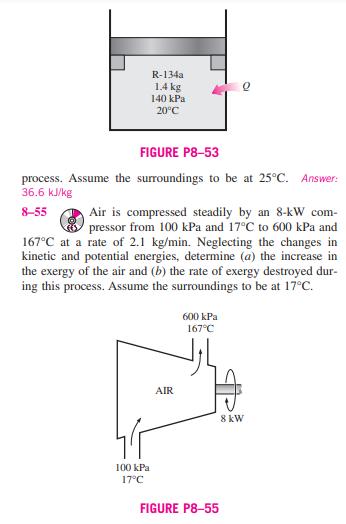Answered step by step
Verified Expert Solution
Question
1 Approved Answer
8-51 Carbon steel balls (p = 7833 kg/m and cp = 0.465 kJ/kg. C) 8 mm in diameter are annealed by heating them first




8-51 Carbon steel balls (p = 7833 kg/m and cp = 0.465 kJ/kg. C) 8 mm in diameter are annealed by heating them first to 900C in a furnace and then allowing them to cool slowly to 100C in ambient air at 35C. If 1200 balls are to be annealed per hour, determine (a) the rate of heat transfer from the balls to the air and (b) the rate of exergy destruction due to heat loss from the balls to the air. Answers: (a) 260 W, (b) 146 W Furnace Air, 35C 900C Steel ball 100C FIGURE P8-51 8-52 A 0.04-m tank initially contains air at ambient condi- tions of 100 kPa and 22C. Now, a 15-liter tank containing liq- uid water at 85C is placed into the tank without causing any air to escape. After some heat transfer from the water to the air and the surroundings, both the air and water are measured to be at 44C. Determine (a) the amount of heat lost to the sur- roundings and (b) the exergy destruction during this process. Air, 22C Water 85C 15 L FIGURE P8-52 8-53 A piston-cylinder device initially contains 1.4 kg of refrigerant-134a at 140 kPa and 20C. Heat is now transferred to the refrigerant, and the piston, which is resting on a set of stops, starts moving when the pressure inside reaches 180 kPa. Heat transfer continues until the temperature reaches 120C. Assuming the surroundings to be at 25C and 100 kPa, deter- mine (a) the work done, (b) the heat transfer, (c) the exergy destroyed, and (d) the second-law efficiency of this process. Answers: (a) 2.57 kJ, (b) 120 kJ, (c) 13.5 kJ, (d) 0.078 Exergy Analysis of Control Volumes 8-54 Steam is throttled from 8 MPa and 450C to 6 MPa. Determine the wasted work potential during this throttling R-134a 1.4 kg 140 kPa 20C FIGURE P8-53 process. Assume the surroundings to be at 25C. Answer: 36.6 kJ/kg 8-55 Air is compressed steadily by an 8-kW com- pressor from 100 kPa and 17C to 600 kPa and 167C at a rate of 2.1 kg/min. Neglecting the changes in kinetic and potential energies, determine (a) the increase in the exergy of the air and (b) the rate of exergy destroyed dur- ing this process. Assume the surroundings to be at 17C. 600 kPa 167C 100 kPa 17C AIR FIGURE P8-55 8 kW 8-56 EES Reconsider Prob. 8-55. Using EES (or other) software, solve the problem and in addition determine the actual heat transfer, if any, and its direction, the minimum power input (the reversible power), and the com- pressor second-law efficiency. Then interpret the results when the outlet temperature is set to, say, 300C. Explain the val- ues of heat transfer, exergy destroyed, and efficiency when the outlet temperature is set to 209.31C and mass flow rate to 2.466 kg/min.
Step by Step Solution
There are 3 Steps involved in it
Step: 1

Get Instant Access to Expert-Tailored Solutions
See step-by-step solutions with expert insights and AI powered tools for academic success
Step: 2

Step: 3

Ace Your Homework with AI
Get the answers you need in no time with our AI-driven, step-by-step assistance
Get Started


